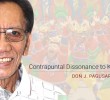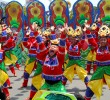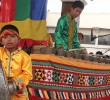Today marks the beginning of the Kadayawan festival, perhaps the festival for which Davao City is most known throughout the country. For the rest of week, numerous public events are lined up for the consumption of locals as well as tourists, such as parades and street dancing, and the popular Hiyas ng Kadayawan pageant in which the contestants represent the different “tribes” that comprise Davao City.
There is no doubt that the foundation upon which the Kadayawan festival rests is the city’s different indigenous groups and its cultural diversity. Begun by the then-mayor Elias B. Lopez (who was lumad himself) in the 1970s, then revived after the Martial Law years as the “Apo Duwaling” festival, it was renamed in 1988 as Kadayawan, which is derived from the greeting “madayaw”, which in turn is related to the Manobo word “marayow”, which means “beautiful”. Based upon an apocryphal account of a Davao “tribal” gathering to give thanks to Manama, it has morphed into what the website www.davaotourism.com calls “a celebration of life, a thanksgiving for the gifts of nature, the wealth of culture, the bounties of harvest, and serenity of living.”
I don’t want to seem like I’m raining on the Kadayawan parade, but it’s quite difficult to get into the festive spirit while carrying the knowledge that the original reason for the celebration – our lumad brothers and sisters – are not in such high spirits themselves, and have not been in such for a long time.
I thought about this last week as I was preparing for a discussion about defending the right to education of the lumads for the UP Mindanao University Student Council General Assembly. I didn’t want to bore the students with numbers and figures, and neither did I want to just pull on their heartstrings or feed romantic or exotic notions about indigenous peoples, so I focused upon the intersections between lumad issues and global and national issues that ordinary students can relate to, and how supporting lumad education is an important – and doable – first step in addressing these.
For example, most everyone would already have heard of human-induced climate change and the ecological crises that we now face at a global level. We would do well to take a page from the lumad’s book and how they have managed to live sustainably for many generations. We can examine the mechanisms by which this works, such as “eco-spirituality”, like demarcating certain portions of forests or waterways as domiciles of spirits with restricted or no access at all, thus maintaining the ecological health of these areas, or the idea that even hunted and butchered animals have a life force that must be respected, and a spirit that must be appeased and thanked, thereby preventing excessive hunting beyond the typical needs of a family or a village.
At the national level, we have a State that apparently has not changed much from the colonial government established by the Americans a little more than a hundred years ago, in that it has maintained elite oligarchies that are more than willing to accommodate America’s foreign interests over that of the Filipino people’s. So many of the political and economic policies adopted by this Filipino-run colonial government have been just that – from the Visiting Forces Agreement, to the Mining Act, to our labor export policy and even K to 12. It is also colonial in the sense that it sees IPs still as children to be guided and assimilated into the mainstream (didn’t the Americans call themselves benevolent assimilators?), to wit, the Nancy Catamco incident that was so brazenly patronizing it left me dumbfounded.
That many of these groups fought to sustain their autonomy, and responded in novel ways other than outright capitulation is a lesson we would do well to learn. State dictates (especially a State that may not have the people’s welfare in mind) are not givens, and a “minority” status does not mean one cannot, or should not, put up a principled opposition.
But this would beg the question, if the lumad already know so much, why would they still need formal education? Indeed, as some datus have recounted, their elders were once against change and formal education, with the not-unfounded belief that their way of life was already well-suited for them. But, based upon their experience, their being “uneducated” made them easy prey for the unscrupulous, or easy to dismiss by those who held power in the mainstream. In the face of such treatment and with the aggressive and relentless physical encroaching on their lands and mental encroaching of the thoughts and persuasions of their youth, availing themselves of formal education began to make sense.
Today, these same leaders who were told not to attend formal classes are fiercely defensive of the schools that they built and the way of teaching that they are continually crating in collaboration with mostly volunteer teachers, many of whom themselves belong to marginalized sectors. This is the result of the realization that getting a formal education will not only equip them with the tools they need to fully engage with the mainstream (so that they can go to go toe to toe with their non-IP counterparts), but will, more importantly, allow the flourishing of their own knowledge systems, so that their next generation will be conscientious – and conscious – bearers of their culture, not just for mere preservation, but to wield it in dynamic ways in the genuine exercise of their right to self-determination.
As for us, there is much to learn from the struggle of the lumads, especially the struggle of those who are still in the midst of doing so, such as the bakwits who have been staying in Haran for many months now, such as those who continue to endure militarization in the countryside. Lumad education is empowering not only to them, but also for us.
It would do well for the Kadayawan festival to highlight these issues, but public expressions of culture, especially those sponsored by the State, are often more geared towards presenting a harmonized view of “national” values and ideals than the fissures that are inherent in a society of haves and have-nots.
In the case of Kadayawan, its permeating theme seems to be unity in diversity, with its emphasis on different tribes all coming together for thanksgiving and celebration (its motto a few years ago was “Ten Tribes, One Vibe”). It certainly fits with the concern of a nation with more than a hundred ethnic groups speaking as many languages, if not more.
But what if that diversity is threatened by the very entity that claims to promote it? The closure of IP schools, the disruption of their everyday life because of military encampments, forced recruitment into violent apparatuses of the State such as paramilitary groups, the selling of their land to mining and logging firms – it is cultural diversity and integrity that all these seek to kill. There is nothing more incensing than a government that allows this to happen while profiting – such as through a famous, and lucrative, festival – from that which it is destroying.
There are more fitting tributes for those whom the Kadayawan wishes to celebrate. There are other more fitting ways to honor those who would protect the Philippine eagle, the waling-waling orchid, the durian and other trees that are the icons of the festival, and the cultural and environmental diversity in which these thrive. There is so much more that needs to be done so that come the next Kadayawan, we truly have a reason to celebrate.










